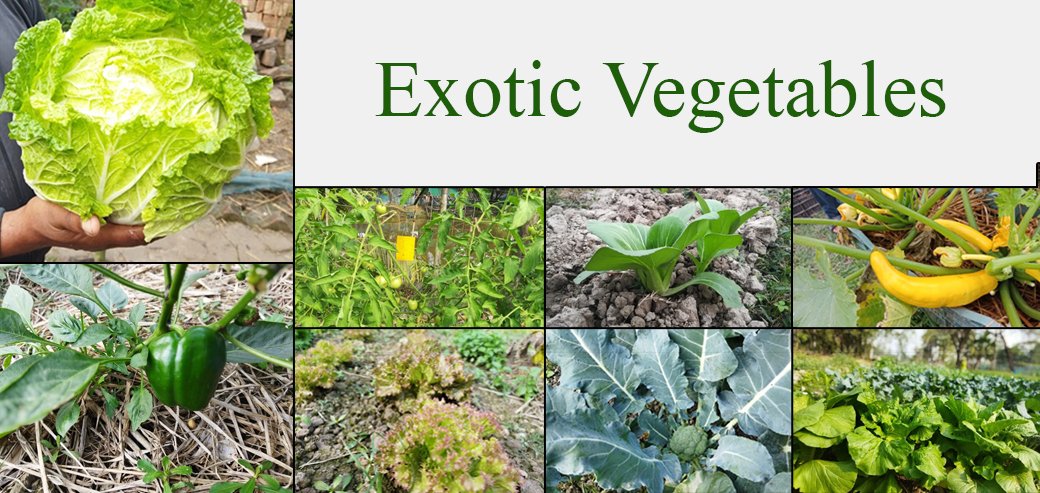Growing exotic vegetables presents unique challenges for farmers due to the specific requirements and market dynamics associated with these crops. Exotic vegetables, such as asparagus, broccoli, zucchini, kale, bok choy, and bell peppers, often require specialized growing conditions, careful management, and strategic marketing to succeed. Here are the major challenges of growing exotic vegetables:
1. Climatic Requirements
- Challenge:
- Many exotic vegetables originate from regions with specific climatic conditions, such as cooler temperatures, controlled humidity, or long daylight hours.
- Growing these vegetables in unsuitable climates requires modifications like greenhouses, shade nets, or controlled environments, which can be costly.
- Example:
- Vegetables like broccoli and kale thrive in cooler climates, making them challenging to grow in tropical or arid regions without climate control.
- Solution:
- Use greenhouses or high tunnels to regulate temperature and humidity.
- Select heat-tolerant or climate-adapted varieties.
2. Soil and Nutrient Management
- Challenge:
- Exotic vegetables often require well-drained, nutrient-rich soil with specific pH levels.
- Nutrient deficiencies or imbalances can significantly impact crop yield and quality.
- Example:
- Asparagus requires deep, well-drained soil with a neutral to slightly alkaline pH, which may not be naturally available in some regions.
- Solution:
- Conduct soil testing and amend soil with organic matter or specific fertilizers.
- Use crop rotation and integrated soil management practices to maintain soil health.
3. High Initial Investment
- Challenge:
- Growing exotic vegetables often involves higher upfront costs for infrastructure (greenhouses, irrigation systems), specialized seeds, fertilizers, and pest control measures.
- Example:
- Setting up drip irrigation or hydroponic systems for zucchini or bell peppers can be expensive for small-scale farmers.
- Solution:
- Seek government subsidies, grants, or loans to offset initial investment costs.
- Start with small-scale production to minimize financial risk.
4. Pest and Disease Susceptibility
- Challenge:
- Exotic vegetables may be more susceptible to pests and diseases that are prevalent in the local environment but not in their native regions.
- Lack of natural resistance to local pests and pathogens can lead to higher crop losses.
- Example:
- Zucchini is prone to powdery mildew and aphid infestations, which require consistent monitoring and control.
- Solution:
- Implement integrated pest management (IPM) strategies, including biological controls, crop rotation, and resistant varieties.
- Use organic pesticides or other environmentally friendly options for pest control.
5. Water and Irrigation Needs
- Challenge:
- Exotic vegetables typically require precise irrigation management to maintain soil moisture levels and avoid water stress.
- Overwatering or under-watering can lead to poor growth and reduced yields.
- Example:
- Lettuce and spinach require consistent moisture, and fluctuations can lead to bolting or poor-quality leaves.
- Solution:
- Use drip or sprinkler irrigation systems for precise water delivery.
- Employ mulching to retain soil moisture and reduce evaporation.
6. Limited Access to High-Quality Seeds
- Challenge:
- High-quality seeds for exotic vegetables may be expensive or difficult to obtain, especially for small-scale farmers in developing regions.
- Imported seeds may not adapt well to local growing conditions.
- Example:
- Hybrid seeds for broccoli or bell peppers are often expensive and may require specific growing conditions to maximize yield.
- Solution:
- Partner with certified seed suppliers for reliable quality.
- Experiment with local seed varieties or save seeds from successful crops.
7. Short Shelf Life
- Challenge:
- Many exotic vegetables are highly perishable and require immediate refrigeration or specialized storage to maintain freshness.
- Inadequate storage and transport infrastructure can lead to significant post-harvest losses.
- Example:
- Leafy greens like arugula and lettuce wilt quickly if not stored in optimal conditions.
- Solution:
- Invest in cold storage facilities or refrigerated transport.
- Establish local markets or partnerships with buyers to reduce transportation times.
8. Lack of Knowledge and Expertise
- Challenge:
- Farmers may lack the technical knowledge required to grow exotic vegetables, such as understanding their specific agronomic practices, pest management, and nutrient requirements.
- Example:
- Growing bok choy requires precise spacing, timely irrigation, and careful pest control to prevent issues like bolting or leaf damage.
- Solution:
- Provide training programs, workshops, or online resources to educate farmers.
- Collaborate with agricultural extension services or research institutions.
9. Market Challenges
- Challenge:
- Exotic vegetables often target niche markets, making demand unpredictable and prices volatile.
- Farmers may struggle to find buyers, especially in regions where these vegetables are not commonly consumed.
- Example:
- Farmers growing kale may face difficulties selling it in markets where traditional leafy greens dominate consumer preferences.
- Solution:
- Conduct market research to identify potential buyers, including restaurants, hotels, or specialty stores.
- Develop direct-to-consumer sales channels, such as farmers’ markets or online platforms.
10. Competition and Pricing Pressure
- Challenge:
- Farmers may face competition from imported exotic vegetables, which can often be cheaper or of higher quality due to better infrastructure and economies of scale in exporting countries.
- Price fluctuations can affect profitability.
- Example:
- Imported bell peppers may compete with locally grown ones in terms of price and presentation.
- Solution:
- Focus on quality, freshness, and local branding to differentiate products.
- Explore organic certification or niche markets to command premium prices.
11. Regulatory and Certification Requirements
- Challenge:
- Meeting regulatory standards for export or organic certification can be complex and costly.
- Example:
- Farmers may need to adhere to stringent pesticide residue limits or organic farming standards to access premium markets.
- Solution:
- Work with agricultural cooperatives or government programs to simplify compliance processes.
- Seek certification through local or regional bodies for better market access.
12. High Labor Intensity
- Challenge:
- Exotic vegetables often require intensive manual labor for planting, harvesting, and post-harvest handling.
- Labor shortages or high labor costs can impact profitability.
- Example:
- Harvesting asparagus requires careful manual handling to avoid damaging the spears.
- Solution:
- Invest in mechanization where feasible, such as automatic seeders or harvesters.
- Train local labor to improve efficiency and reduce costs.
13. Sensitivity to Local Consumer Preferences
- Challenge:
- Exotic vegetables may not align with local dietary habits, making it difficult to generate consistent demand.
- Example:
- Zucchini or kale might not appeal to traditional consumers in regions where indigenous vegetables dominate.
- Solution:
- Promote awareness of the nutritional benefits and culinary versatility of exotic vegetables.
- Work with chefs, influencers, or cooking classes to introduce exotic vegetables to local cuisines.
14. Export and Supply Chain Challenges
- Challenge:
- For farmers targeting export markets, logistics, tariffs, and quality standards can pose significant barriers.
- Long transportation times can affect the freshness and quality of the produce.
- Example:
- Exporting fresh broccoli requires strict adherence to cold chain protocols to maintain quality.
- Solution:
- Partner with export organizations or cooperatives to streamline supply chains.
- Invest in packaging and cold storage infrastructure to meet export standards.
Conclusion
Growing exotic vegetables can be highly rewarding but comes with significant challenges, including climatic requirements, market access, pest and disease management, and high initial costs. To succeed, farmers need to invest in proper infrastructure, acquire technical knowledge, and develop strong market linkages. Addressing these challenges with innovative solutions, such as controlled-environment agriculture, direct marketing, and partnerships, can help farmers tap into the growing demand for exotic vegetables and achieve long-term profitability.
Hashtags
#OrganicFarming #FarmToTable #LocalProduce #SmallScaleFarming #CropDiversity #FarmersMarket #HealthyEating #FoodSecurity #EcoFriendly #FarmLife #FreshProduce #HarvestSeason #FarmersOfInstagram #SupportLocalFarmers #CommunitySupportedAgriculture #FarmFresh #FoodSustainability #FarmersPride #InnovativeFarming #FarmersSuccess









